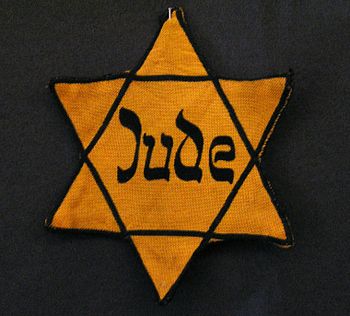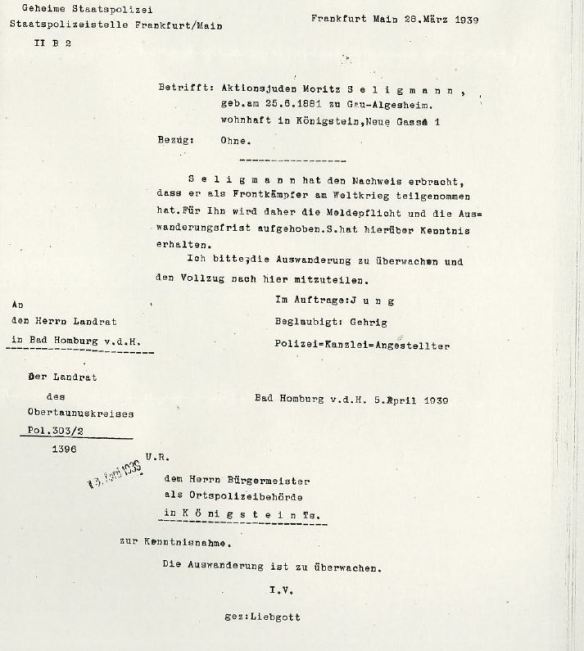Three of the four surviving children of Gerson Blumenfeld II made it out of Germany in time to escape from the Nazis.
The family of Mina Blumenfeld Simon were the first descendants of Gerson Blumenfeld II to leave Germany. Mina’s son Josef arrived in New York on February 5, 1937. He listed his occupation as a butcher and his prior residence as Wetzlar, a town near Hermannstein where he was born.

Josef Simon ship manifest, Year: 1937; Arrival: New York, New York, USA; Microfilm Serial: T715, 1897-1957; Line: 10; Page Number: 35, New York Passenger Lists, 1820-1957, Ancestry.com
His brother Kurt arrived eight months later on October 1, 1937; he listed his occupation as a merchant and last residence as Wetzlar.

Kurt Simon ship manifest, Year: 1937; Arrival: New York, New York, USA; Microfilm Serial: T715, 1897-1957; Line: 3; Page Number: 38, Ship or Roll Number: New York, Ancestry.com. New York, U.S., Arriving Passenger and Crew Lists (including Castle Garden and Ellis Island), 1820-1957
The rest of the family—Albert, Mina, and Grete—arrived the following year on August 18, 1938. They also had been living in Wetzlar where Albert was a merchant.

Albert Meta Grete Simon passenger manifest, Year: 1938; Arrival: New York, New York, USA; Microfilm Serial: T715, 1897-1957; Line: 12; Page Number: 8, Ship or Roll Number: Washington
Ancestry.com. New York, U.S., Arriving Passenger and Crew Lists (including Castle Garden and Ellis Island), 1820-1957
Mina had officially changed her name from Mina Blumenfeld Simon to Meta Simon by the time she filed her Declaration of Intention to become a US citizen on January 24, 1939.

Meta Blumenfeld Simon declaration of intention, The National Archives at Philadelphia; Philadelphia, PA; NAI Title: Declarations of Intention For Citizenship, 1/19/1842 – 10/29/1959; NAI Number: 4713410; Record Group Title: Records of District Courts of the United States, 1685-2009; Record Group Number: 21, (Roll 549) Declarations of Intention For Citizenship, 1842-1959 (No 427401-428300), Ancestry.com. New York, U.S., State and Federal Naturalization Records, 1794-1943
The family was reunited and living together as of the 1940 US census. They were living in New York City, and Albert and his two sons Kurt and Joseph (as spelled here) were working as butchers.

Albert Simon and family 1940 US census, Year: 1940; Census Place: New York, New York, New York; Roll: m-t0627-02670; Page: 11B; Enumeration District: 31-1895, Ancestry.com. 1940 United States Federal Census
Friedrich Blumenfeld and his family, including his mother Berta Alexander Blumenfeld, were the next family members to arrive in the US. They left shortly after Kristallnacht.
I had the great pleasure of Zooming with two of Friedrich’s grandsons last week, Steven and Milton, and they shared with me a story about their grandmother Berta’s reaction to Kristallnacht. Apparently when the Nazis came around to arrest Jewish men in the aftermath of Kristallnacht, Berta was so angry that she took the medals awarded to the family in honor of Moritz and Isaak, the two sons who died fighting for Germany in World War I, and threw them at the Nazi soldiers, yelling that she had lost two sons already. According to the family, the soldiers backed off and left the family alone. Soon thereafter the family was able to get visas to leave Germany.1
Friedrich, Berta, and their two children arrived in the US on January 13, 1939. Friedrich’s occupation on the ship manifest is listed as shoe manufacturing, but his grandsons told me he was actually a dry goods salesman in Momberg.

Friedrich Blumenfeld and family passenger manifest, Year: 1939; Arrival: New York, New York, USA; Microfilm Serial: T715, 1897-1957; Line: 23; Page Number: 150, Ship or Roll Number: Hansa
Ancestry.com. New York, U.S., Arriving Passenger and Crew Lists (including Castle Garden and Ellis Island), 1820-1957
I cannot locate them on the 1940 census, but on October 16, 1939, they were all living together in the Bronx, according to Friedrich’s Declaration of Intention filed on that date. Friedrich was unemployed at that time.

Friedrich Blumenfeld declaration of intention, The National Archives at Philadelphia; Philadelphia, PA; NAI Title: Declarations of Intention For Citizenship, 1/19/1842 – 10/29/1959; NAI Number: 4713410; Record Group Title: Records of District Courts of the United States, 1685-2009; Record Group Number: 21, (Roll 567) Declarations of Intention For Citizenship, 1842-1959 (No 444001-444900), Ancestry.com. New York, U.S., State and Federal Naturalization Records, 1794-1943
Katinka Blumenfeld Rosenberg was the last of the children of Gerson Blumenfeld II to escape Nazi Germany in time. Their departure was delayed because, as I learned from Katinka’s son Heinz/Henry, after Kristallnacht, Katinka’s husband Emanuel and son Walter were taken to Buchenwald where Walter spent two months and Emanuel spent five weeks. After they were released in early 1939, the family was determined to leave, but it was very difficult to find a sponsor to help them get permission to immigrate to the US. Finally a stranger from Texas who was not even related to the family came forward with an affidavit and sponsored the family. They took a train to Italy and sailed to the US from Genoa. As Henry and I discussed during our conversation, it is somewhat miraculous that they were to get out of Germany after World War II had started since for so many the borders closed after September 1, 1939.2
Katinka, her husband Emanuel Rosenberg, and their three sons Walter, Guenter, and Heinz arrived in New York on February 1, 1940. Emanuel listed his occupation as a trader, and Momberg was their last residence.

Emanuel Rosenberg and family passenger manifest, Year: 1940; Arrival: New York, New York, USA; Microfilm Serial: T715, 1897-1957; Line: 6; Page Number: 37, Ship or Roll Number: Conte Di Savoia, Ancestry.com. New York, U.S., Arriving Passenger and Crew Lists (including Castle Garden and Ellis Island), 1820-1957
Henry said they at first lived with cousins in the Bronx, but soon moved to Washington Heights in Manhattan where so many German Jewish refugees settled in the 1930s and 1940s. Henry quickly learned English and soon was able to not only catch up with his classmates but to excel in school.3
When the 1940 US census was taken a few months after their arrival, the Rosenbergs were all living in New York City. Emanuel was working in a grocery store, and Walter was a machine operator in a watch factory.

Emanuel Rosenberg and family 1940 US census,Year: 1940; Census Place: New York, New York, New York; Roll: m-t0627-02670; Page: 9A; Enumeration District: 31-1887, Ancestry.com. 1940 United States Federal Census
Thus, Mina, Friedrich, and Katinka and their families were able to escape to the US in time and survived the Holocaust.
Tragically, the youngest child of Gerson Blumenfeld II, Sitta Blumenfeld Spier, did not leave Germany in time to escape the Holocaust. Her family’s story in my next post.
I will be taking next week off to be with my family, who are coming to visit for Thanksgiving. Have a great Thanksgiving to all my US readers!












![Iserlohn By No machine-readable author provided. Asio otus assumed (based on copyright claims). [GFDL (http://www.gnu.org/copyleft/fdl.html), CC-BY-SA-3.0 (http://creativecommons.org/licenses/by-sa/3.0/) or CC BY-SA 2.5-2.0-1.0 (http://creativecommons.org/licenses/by-sa/2.5-2.0-1.0)], via Wikimedia Commons](https://brotmanblog.files.wordpress.com/2016/03/iserlohn-muehlentor1-asio.jpg?w=584)
![Buchenwald Watch Tower undesarchiv, Bild 183-1983-0825-303 / CC-BY-SA 3.0 [CC BY-SA 3.0 de (http://creativecommons.org/licenses/by-sa/3.0/de/deed.en)], via Wikimedia Commons](https://brotmanblog.files.wordpress.com/2016/03/buchenwald.jpg?w=584)

![Crematoria at Majdanek death camp near Lublin, Poland Deutsche Fotothek [CC BY-SA 3.0 de (http://creativecommons.org/licenses/by-sa/3.0/de/deed.en)], via Wikimedia Commons](https://brotmanblog.files.wordpress.com/2016/03/majdanek-crematoria.jpg?w=584&h=368)














